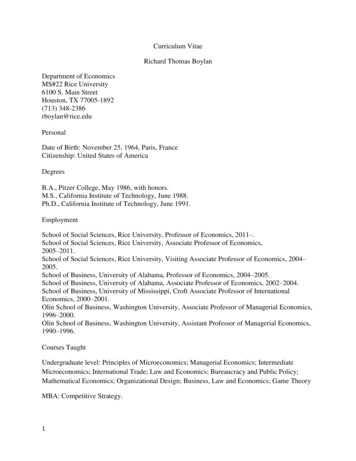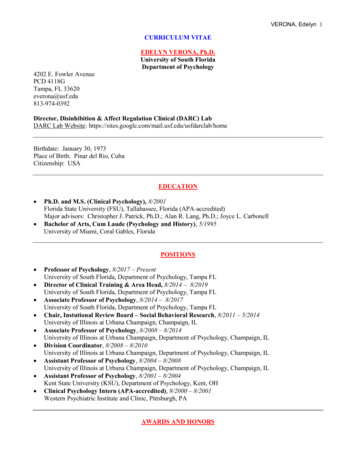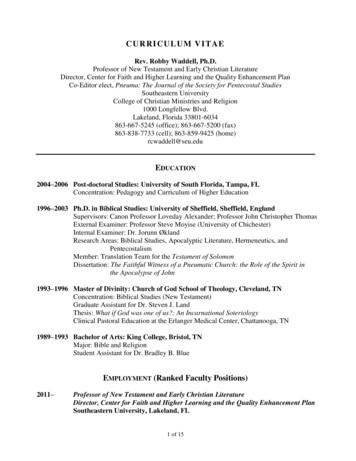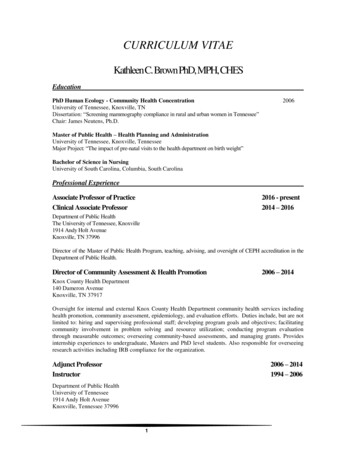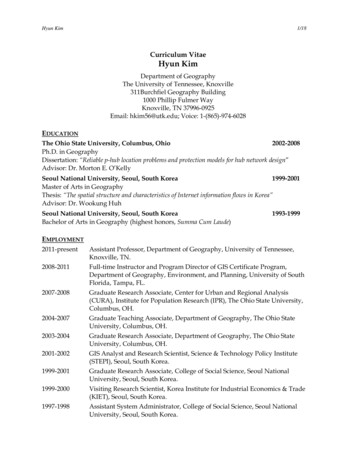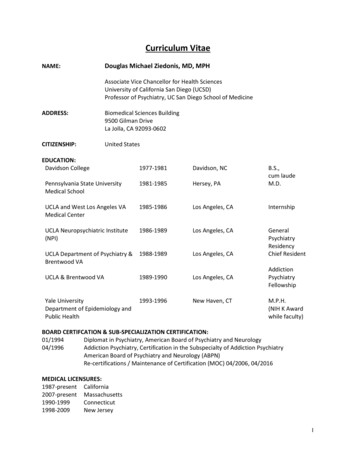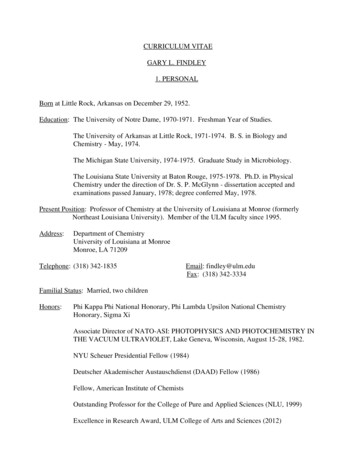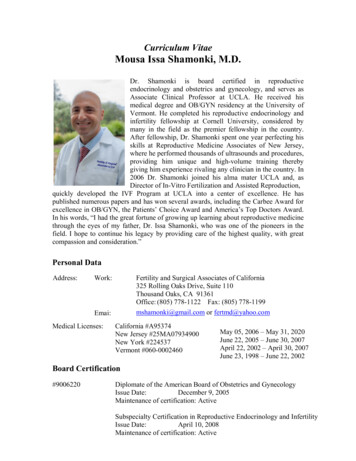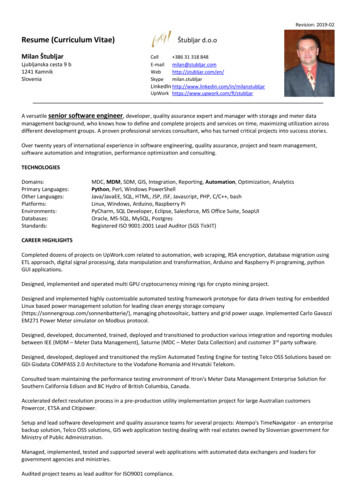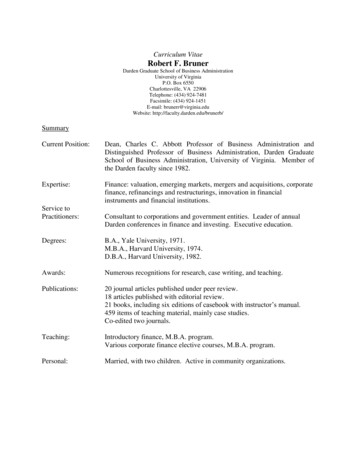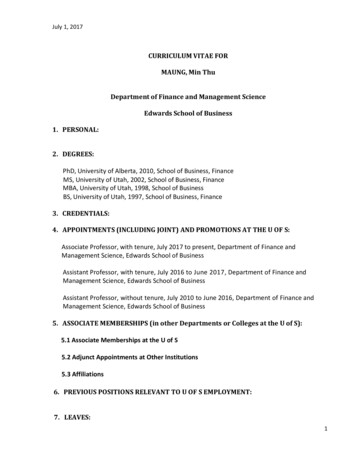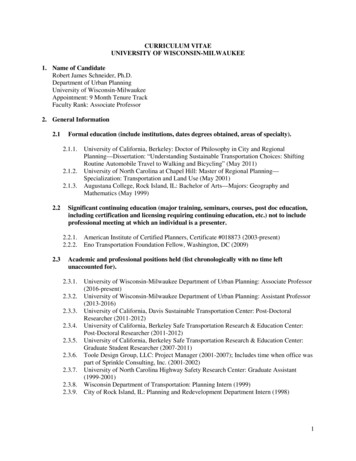
Transcription
CURRICULUM VITAEUNIVERSITY OF WISCONSIN-MILWAUKEE1. Name of CandidateRobert James Schneider, Ph.D.Department of Urban PlanningUniversity of Wisconsin-MilwaukeeAppointment: 9 Month Tenure TrackFaculty Rank: Associate Professor2. General Information2.1Formal education (include institutions, dates degrees obtained, areas of specialty).2.1.1.2.1.2.2.1.3.2.2Significant continuing education (major training, seminars, courses, post doc education,including certification and licensing requiring continuing education, etc.) not to includeprofessional meeting at which an individual is a presenter.2.2.1.2.2.2.2.3University of California, Berkeley: Doctor of Philosophy in City and RegionalPlanning—Dissertation: “Understanding Sustainable Transportation Choices: ShiftingRoutine Automobile Travel to Walking and Bicycling” (May 2011)University of North Carolina at Chapel Hill: Master of Regional Planning—Specialization: Transportation and Land Use (May 2001)Augustana College, Rock Island, IL: Bachelor of Arts—Majors: Geography andMathematics (May 1999)American Institute of Certified Planners, Certificate #018873 (2003-present)Eno Transportation Foundation Fellow, Washington, DC (2009)Academic and professional positions held (list chronologically with no time leftunaccounted .8.2.3.9.University of Wisconsin-Milwaukee Department of Urban Planning: Associate Professor(2016-present)University of Wisconsin-Milwaukee Department of Urban Planning: Assistant Professor(2013-2016)University of California, Davis Sustainable Transportation Center: Post-DoctoralResearcher (2011-2012)University of California, Berkeley Safe Transportation Research & Education Center:Post-Doctoral Researcher (2011-2012)University of California, Berkeley Safe Transportation Research & Education Center:Graduate Student Researcher (2007-2011)Toole Design Group, LLC: Project Manager (2001-2007); Includes time when office waspart of Sprinkle Consulting, Inc. (2001-2002)University of North Carolina Highway Safety Research Center: Graduate Assistant(1999-2001)Wisconsin Department of Transportation: Planning Intern (1999)City of Rock Island, IL: Planning and Redevelopment Department Intern (1998)1
3. Research, Scholarship, and Professional Activities3.1Articles and papers published or accepted for publication in academic and professionalprint and electronic journals (indicate method of selection – e.g., invited or refereed).Safety Analysis Articles3.1.1. Schneider, R.J., R.L. Sanders, F.R. Proulx, and H. Moayyed. “United States FatalPedestrian Crash Hot Spot Locations and Characteristics,” Journal of Transport andLand Use, Forthcoming, 2020. (refereed)3.1.2. Schneider, R.J. “United States Pedestrian Fatality Trends, 1977 to 2016,”Transportation Research Record: Journal of the Transportation Research Board,Volume 2674, Number 9, pp. 1069-1083. DOI: 10.1177/0361198120933636, 2020.(refereed)3.1.3. Al-Mahameed, F., X. Qin, R.J. Schneider, and M.R. Shaon. “Analyzing Pedestrian andBicyclist Crashes at the Corridor Level: Structural Equation Modeling Approach,”Transportation Research Record: Journal of the Transportation Research Board,Volume 2673, Number 7, pp. 308-318, DOI: https://doi.org/10.1177/0361198119845353,2019. (refereed)3.1.4. Schneider, R.J., A. Sanatizadeh, M.R. Shaon, Z. He, and X. Qin. “Exploratory Analysisof Driver Yielding at Low-Speed, Uncontrolled Crosswalks in Milwaukee, Wisconsin,”Transportation Research Record: Journal of the Transportation Research Board,Volume 2672, Number 35, pp. 21-32, DOI: 10.1177/0361198118782251, 2018.(refereed)3.1.5. Shaon, M.R., Schneider, R.J., X. Qin, Z. He, A. Sanatizadeh, and M.D. Flanagan.“Exploration of Pedestrian Assertiveness and Its Association with Driver YieldingBehavior at Uncontrolled Crosswalks,” Transportation Research Record: Journal of theTransportation Research Board, DOI: 10.1177/0361198118790645, 2018. (refereed)3.1.6. Schneider, R.J., J. Vargo, and A. Sanatizadeh. “Comparison of US Metropolitan RegionPedestrian and Bicyclist Fatality Rates,” Accident Analysis and Prevention, Volume 106,pp. 82-98, 2017. (refereed)3.1.7. Schneider, R.J. and J. Stefanich. “Application of the Location-Movement ClassificationMethod for Pedestrian and Bicycle Crash Typing,” Transportation Research Record:Journal of the Transportation Research Board, Volume 2601, pp. 72-83, 2016. (refereed)3.1.8. Schneider, R.J. and R.L. Sanders. “Pedestrian Safety Practitioners’ Perspectives ofDriver Yielding Behavior across North America,” Transportation Research Record:Journal of the Transportation Research Board, Volume 2519, pp. 39-50, 2015. (refereed)3.1.9. Schneider, R.J. “Walk or Drive Between Stores? Designing Neighborhood ShoppingDistricts for Pedestrian Activity,” Journal of Urban Design, Volume 20, Number 2, pp.212-229, 2015. (refereed)3.1.10. Schneider, R.J., O. Grembek, and M. Braughton. “Pedestrian Crash Risk on BoundaryRoadways: A University Campus Case Study,” Transportation Research Record:Journal of the Transportation Research Board, Volume 2393, pp. 164-173, 2013.(refereed)3.1.11. Cooper, J.F., R.J. Schneider, S. Ryan, and S. Co. “Documenting Targeted BehaviorsAssociated with Pedestrian Safety,” Transportation Research Record: Journal of theTransportation Research Board, Volume 2299, pp. 1-10, 2012. (refereed)3.1.12. Schneider, R.J., M.C. Diogenes, L.S. Arnold, V. Attaset, J. Griswold, and D.R. Ragland.“Association between Roadway Intersection Characteristics and Pedestrian Crash Risk inAlameda County, California,” Transportation Research Record: Journal of theTransportation Research Board, Volume 2198, pp. 41-51, 2010. (refereed)2
3.1.13. Hummer, J.E., N. Rouphail, R.G. Hughes, S.J. Fain, J.L. Toole, R.S. Patten, R.J.Schneider, J.F. Monahan, and A. Do. “User Perceptions of the Quality of Service onShared Use Paths,” Transportation Research Record: Journal of the TransportationResearch Board, Volume 1939, Transportation Research Board, 2005. (refereed)3.1.14. Schneider, R.J., R.M. Ryznar, and A.J. Khattak. “An Accident Waiting to Happen: aSpatial Approach to Proactive Pedestrian Planning,” Accident Analysis and Prevention,Volume 36, pp. 193-211, 2004. (refereed)3.1.15. Schneider, R.J., A.J. Khattak, and C.V. Zegeer. “A Proactive Method of ImprovingPedestrian Safety Using GIS: Example from a College Campus,” TransportationResearch Record: Journal of the Transportation Research Board, Volume 1773,Transportation Research Board, 2002. (refereed)Travel Behavior Articles3.1.16. Currans, K.M., G. Abou-Zeid, K.J. Clifton, A. Howell, and R.J. Schneider. “ImprovingTransportation Impact Analyses for Subsidized Affordable Housing Developments: AData Collection and Analysis of Motorized Vehicle and Person Trip Generation,” Cities,Volume 103, DOI: https://doi.org/10.1016/j.cities.2020.102774, 2020. (refereed)3.1.17. Schneider, R.J. and J. Willman. “Move Closer and Get Active: How to Make UrbanUniversity Commutes more Satisfying,” Transportation Research Part F: TrafficPsychology and Behavior, Volume 60, 462-473, 2019. (refereed)3.1.18. Griswold, J.B., A. Medury, R.J. Schneider, D. Amos, A. Li, and O. Grembek. “APedestrian Exposure Model for the California State Highway System,” TransportationResearch Record: Journal of the Transportation Research Board, Volume 2673, Number4, pp. 941-950, DOI: 10.1177/0361198119837235, 2019. (refereed)3.1.19. Schneider, R.J., J. Kusch, A. Dressel, and R. Bernstein. “Can a Twelve-WeekIntervention Reduce Barriers to Bicycling Among Overweight Adults in Low-IncomeLatino and Black Communities?” Transportation Research Part F: Traffic Psychologyand Behavior, Volume 56, pp. 99-112, https://doi.org/10.1016/j.trf.2018.03.023, 2018.(refereed)3.1.20. Schneider, R.J., L. Hu, and J. Stefanich. “Exploring the Value of Detailed EnvironmentVariables in Neighborhood Commute Mode Share Models,” Journal of Transport andLand Use, Volume 11, Number 1, pp. 921–938, 2018. (refereed)3.1.21. Singleton, P., J.C. Totten, J.P. Orrego-Oñate, R.J. Schneider, and K.J. Clifton. “MakingStrides: State of the Practice of Pedestrian Forecasting in Regional Travel Models,”Transportation Research Record: Journal of the Transportation Research Board, DOI:10.1177/0361198118773555, 2018.3.1.22. Schneider, R.J., L. Hu, and J. Stefanich. “Development of a Neighborhood CommuteMode Share Model Using Nationally-Available Data,” 9813-z, 2017. (refereed)3.1.23. Hu, L. and R.J. Schneider. “Different Ways to get to the Same Workplace: How doesWorkplace Location Relate to Commuting by Different Income Groups?” TransportPolicy, Volume 59, pp. 106-115, 2017. (refereed)3.1.24. Bernstein, R., R.J. Schneider, W. Welch, A. Dressel, M. DeNomie, J. Kusch, and M.Sosa. “Biking for Health; Results of a Pilot Randomized Controlled Trial Examining theBehavioral, Fitness, and Health Impact of a Bicycling Intervention on Lower-IncomeAdults,” Wisconsin Medical Journal, Volume 116, pp. 154-160, 2017. (refereed)3.1.25. Clifton, K.J., P.A. Singleton, C.D. Muhs, and R.J. Schneider. “Development ofDestination Choice Models for Pedestrian Travel,” Transportation Research Part A,Volume 94, pp. 255-265, 2016. (refereed)3
3.1.26. Clifton, K.J., P.A. Singleton, C.D. Muhs, and R.J. Schneider. “Representing PedestrianActivity in Travel Demand Models: Framework and Application,” Journal of TransportGeography, Volume 52, pp. 111-122, 2016. (refereed)3.1.27. Schneider, R.J. and J. Stefanich. “Neighborhood Characteristics that Support BicycleCommuting: Analysis of the Top 100 United States Census Tracts,” TransportationResearch Record: Journal of the Transportation Research Board, Volume 2520, pp. 4151, 2015. (refereed)3.1.28. Schneider, R.J. “Local Environment Characteristics Associated with Walking andTaking Transit to Shopping Districts,” Journal of Transport and Land Use, Volume 8,Number 2, 2015. (refereed)3.1.29. Schneider, R.J., K. Shafizadeh, and S.L. Handy. “Method to Adjust Institute ofTransportation Engineers Vehicle Trip-Generation Estimates in Smart-Growth Areas,”Journal of Transport and Land Use, Volume 8, Number 1, pp. 69-83, 2015. (refereed)3.1.30. Schneider, R.J. and L. Hu. “Improving University Transportation Sustainability:Reducing Barriers to Campus Bus and Bicycle Commuting,” The International Journalof Sustainability Policy and Practice, Volume 11, Number 1, 2015. ISSN: 2325-1166.(refereed)3.1.31. Hu, L. and R.J. Schneider. “Shifts between Automobile, Bus, and Bicycle Commutingin an Urban Setting,” Journal of Urban Planning and Development, Volume 141, Issue 2,2014. (refereed)3.1.32. Schneider, R.J., S.L. Handy, and K. Shafizadeh. “Trip Generation for Smart GrowthProjects,” Access, Number 45, pp. 9-15, Fall 2014. (invited and reviewed by editor)3.1.33. Schneider, R.J. “Theory of Routine Mode Choice Decisions: An OperationalFramework to Increase Sustainable Transportation,” Transport Policy, Volume 25, pp.128-137, 2013. (refereed)3.1.34. Schneider, R.J., T. Henry, M.F. Mitman, L. Stonehill, and J. Koehler. “Developmentand Application of the San Francisco Pedestrian Intersection Volume Model,”Transportation Research Record: Journal of the Transportation Research Board,Volume 2299, pp. 65-78, 2012. (refereed)3.1.35. Clifton, K.J., K.M. Currans, A.C. Cutter, and R.J. Schneider. “Household TravelSurveys in Context-Based Approach for Adjusting ITE Trip Generation Rates in UrbanContexts,” Transportation Research Record: Journal of the Transportation ResearchBoard, Volume 2307, pp. 108-119, 2012. (refereed)3.1.36. Griswold, J.B., A. Medury, and R.J. Schneider. “Pilot Models for Estimating BicycleIntersection Volumes,” Transportation Research Record: Journal of the TransportationResearch Board, Volume 2247, pp. 1-7, 2011. (refereed)3.1.37. Schneider R.J., L.S. Arnold, and D.R. Ragland. “A Pilot Model for EstimatingPedestrian Intersection Crossing Volumes,” Transportation Research Record: Journal ofthe Transportation Research Board, Volume 2140, pp. 13-26, 2009. (refereed)Performance Measurement Articles3.1.38. Griswold, J.B., A. Medury, R.J. Schneider, and O. Grembek. “Comparison of PedestrianCount Expansion Methods: Land Use Groups versus Empirical Clusters,” TransportationResearch Record: Journal of the Transportation Research Board, DOI:10.1177/0361198118793006, 2018.3.1.39. Dressel, A., R.J. Schneider, M. Denomie, J. Kusch, W. Welch, M. Sosa, S. Yeldell, T.Maida, J. Wineberg, K. Holt, and R. Bernstein. “Assessing Health PromotionInterventions: Limitations of Traditional Research Methods in Community-BasedStudies,” Health Promotion Practice, Volume 19, Issue 4, DOI:10.1177/1524839917725489, 2018. (refereed)4
3.1.40. Proulx, F.R., R.J. Schneider, and L.F. Miranda-Moreno. “Performance Evaluation andCorrection Functions for Automated Pedestrian and Bicycle Counting Technologies,”Journal of Transportation Engineering, Volume 142, Number 3,10.1061/(ASCE)TE.1943-5436.0000828, 04016002, 2016. (refereed)3.1.41. Schneider, R.J. “Measuring Transportation at a Human Scale: An Intercept SurveyApproach to Capture Pedestrian Activity,” Journal of Transport and Land Use, Volume6, Number 3, pp. 43-59, 2013. (refereed)3.1.42. Schneider, R.J., K. Shafizadeh, B.R. Sperry, and S.L. Handy. “Methodology to GatherMultimodal Trip Generation Data in Smart-Growth Areas,” Transportation ResearchRecord: Journal of the Transportation Research Board, Volume 2354, pp. 68-85, 2013.(refereed)3.1.43. Miranda-Moreno, L.F., T. Nosal, R.J. Schneider, and F. Proulx. “Classification ofBicycle Traffic Patterns in Five North American Cities,” Transportation ResearchRecord: Journal of the Transportation Research Board, Volume 2339, pp. 68-79, 2013.(refereed)3.1.44. Schneider, R.J. and S. Pande. “How Common is Pedestrian Travel To, From, andWithin Shopping Districts?” Transportation Research Record: Journal of theTransportation Research Board, Volume 2299, pp. 11-21, 2012. (refereed)3.1.45. Schneider, R.J., L.S. Arnold, and D.R. Ragland. “A Methodology for CountingPedestrians at Intersections: Using Automated Counters to Extrapolate Weekly Volumesfrom Short Manual Counts,” Transportation Research Record: Journal of theTransportation Research Board, Volume 2140, pp. 1-12, 2009. (refereed)3.1.46. Schneider, R.J., L.C. Dunbar, J.L. Toole, and C. Flink. “Avoiding Biased Interpretationof Bicycle Surveys: Comparing Results from Four Distribution Methods in WinstonSalem, NC,” Transportation Research Record: Journal of the Transportation ResearchBoard, Volume 1982, Transportation Research Board, 2006. (refereed)3.1.47. Schneider, R.J., R.S. Patten, and J.L. Toole. “Case Study Analysis of Pedestrian andBicycle Data Collection in United States Communities,” Transportation ResearchRecord: Journal of the Transportation Research Board, Volume 1939, TransportationResearch Board, 2005. (refereed)Other Articles3.1.48. Schneider, R.J., S. Kothuri, L. Blackburn, K. Manaugh, L. Sandt, and J. Fish. PedestrianTransportation Research: Past and Future, Transportation Research Board CentennialPaper, pers/ANF10-Final.pdf, 2020.(invited and reviewed by editor)3.1.49. Schneider, R., E. Raynault, and R. Buehler, “Assessing Active Transportation andHealth: Conference Highlights Innovative Practices and Research,” TR News, Volume299, pp. 47-49, September-October 2015. (invited)3.1.50. Goodman, D., R. Schneider, and T. Griffiths. “Put Your Money Where the People Are,”Planning, June 2009. (invited and reviewed by editor)3.1.51. Schneider, R.J. “Changing Institutional Structures to Improve the Coordination of LandUse and Transportation in the Research Triangle Region, North Carolina,” CarolinaPlanning, Spring 2001. (refereed)3.2Books, monographs, and other publications published by major university or commercialpublishing houses and other appropriate publishers.3.2.1.Currently collaborating with Dr. João de Abreu e Silva (Técnico Lisboa), Dr. KristinaCurrans (University of Arizona), and Dr. Veronique Van Acker (Luxembourg Instituteof Socio-Economic Research) on a book titled, Handbook on Transportation and Land5
Use: Human-Centered Communities in an Age of Rapid Technological Change, forEdward Elgar Publishing. Publication anticipated in 2021.3.3 Chapters in books published by appropriate publishers (indicate method of selection).3.3.1.3.3.2.Schneider, R.J. “Mode Share/Mode Choice,” Encyclopedia of Transportation, SAGEPublications, 2014. (invited and reviewed by editor)Schneider, R.J. “Pedestrian Safety,” Encyclopedia of Transportation, SAGEPublications, 2014. (invited and reviewed by editor)3.4Proprietary and non-proprietary technical reports.3.5Training manuals (indicate publisher, method of selection, and range of distribution).3.6Computer software (indicate publisher, method of selection, and range of distribution).3.7Instructional aids (indicate publisher, method of selection, and range of distribution).3.8Psychometric and evaluative instruments (indicate publisher, method of selection, andrange of distribution).3.9Research projects conducted and grants received (indicate source and amount).Grants Received as UWM Principal Investigator3.9.1. University of Wisconsin-Madison, Center for Transportation Equity Decisions & Dollars(CTEDD), Gender Analysis Tool for Complete Streets Policy Implementation (20202021) ( 1,500)3.9.2. Wisconsin Department of Transportation, Pedestrian Exposure Data for the WisconsinState Highway System: WisDOT Southeast Region Pilot Study (2019-2021) ( 50,000)3.9.3. Wisconsin Department of Transportation, Comprehensive Evaluation of DT4000 DataQuality for Pedestrian and Bike Crashes (2019-2020) ( 9,198)3.9.4. Medical College of Wisconsin, Safe & Healthy Streets: Enhancing Systems to IncreaseWalking & Biking Infrastructure in Milwaukee (subconsultant to Wisconsin BicycleFederation) (2018-2021) ( 9,296) (Updated to 15,901)3.9.5. UW-Madison Global Health Institute, Gender Analysis and Global Learning for Safe andHealthy Streets: Implementing a Complete Streets Policy in Milwaukee, WI(subconsultant to UW-Madison Department of Urban Planning and LandscapeArchitecture) (2019-2020) ( 7,000)3.9.6. Medical College of Wisconsin, Transportation Injury Impacts of Streetcar SystemDevelopment (2018-2019) ( 8,166)3.9.7. Milwaukee Department of Public Works, City of Milwaukee Pedestrian Master Plan(subconsultant to Toole Design Group) (2017-2018) ( 27,000)3.9.8. Wisconsin Department of Transportation, Identifying Highly Correlated VariablesRelating to the Potential Causes of Reportable Wisconsin Traffic Crashes (2016-2018)( 3,600)3.9.9. Wisconsin Department of Transportation, High-Visibility Enforcement Evaluation(subconsultant to UW-Madison Traffic Operations and Safety Laboratory) (2016-2017)( 30,000)3.9.10. National Cooperative Highway Research Program, Project 17-73: Systemic PedestrianSafety Analyses (subconsultant to UNC Highway Safety Research Center) (2015-2018)( 5,000)6
3.9.11. University of Wisconsin Milwaukee, Research and Creative Activities Support Grant:Models to Estimate Pedestrian & Bicycle Commuting at the Neighborhood Level (20152016) ( 25,000)3.9.12. University of California, Berkeley, Safe Transportation Research and Education Center:California Pedestrian Safety Improvement Program (2015-present) ( 10,000)3.9.13. National Cooperative Highway Research Program: Project 07-19, Methods andTechnologies for Collecting Pedestrian and Bicycle Volume Data, Phase 2 (subconsultantto Kittelson Associates) (2015-2016) ( 3,500)3.9.14. Seattle Department of Transportation, Seattle Pedestrian and Bicycle Safety Analysis(subconsultant to Toole Design Group) (2015-2016) ( 5,000)3.9.15. Medical College of Wisconsin, Clinical & Translational Science Institute of SoutheastWisconsin (CTSI), Biking for Health: Testing the Benefits of a Bicycle Intervention in aLow-Income Community (2015-2016) ( 7,300)3.9.16. Wisconsin Department of Transportation, Wisconsin Statewid
2.2.1. American Institute of Certified Planners, Certificate #018873 (2003-present) 2.2.2. Eno Transportation Foundation Fellow, Washington, DC (2009) 2.3 Academic and professional positions held (list chronologically with no time left unaccounted for). 2.3.1. University of Wisconsin-Milwaukee
